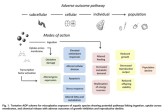 The influence of hydrogen on the structural integrity of nuclear power plant, where water molecules in the coolant circuit can be split by electrolysis or radiolysis to produce hydrogen, has been a concern to engineers for decades. However, plans for a hydrogen economy and commercial fusion reactors, in which plasma-facing structural components will likely be exposed to hydrogen, has accelerated interest in understanding the complex interactions of hydrogen with metals, especially in the presence of irradiation. A key step in advancing our understanding of these interactions is the measurement and prediction of the uptake and release of hydrogen by key structural materials. We have recently published a study in Scientific Reports in which we developed a method for predicting the amount hydrogen in a steel under test conditions. We used a sample of stainless steel as an electrode (cathode) in an electrolysis cell that split water molecules producing hydrogen atoms that were attracted to the steel. After loading the steel with hydrogen in the cell, we measured the rate of release of the hydrogen from the steel over two minutes by monitoring the drop in current in the cell, using a technique called potentiostatic discharge. We used our measurements to calibrate a model of hydrogen release rate, based on Fick’s second law of diffusion, which relates the rate of hydrogen motion (diffusion) to the surface area perpendicular to the motion and the concentration gradient in the direction of motion. Finally, we used our calibrated model to predict the release rate of hydrogen over 24 hours and checked our predictions using a second measurement based on the hydrogen released when the steel was melted. So, now we have a method of predicting the amount of hydrogen in a steel remaining in a sample many hours after exposure during electrolysis without destroying the test sample. This will allow us to perform better defined tests on the influence of hydrogen on the performance of stainless steel in the extreme environments of fission and fusion reactors.
The influence of hydrogen on the structural integrity of nuclear power plant, where water molecules in the coolant circuit can be split by electrolysis or radiolysis to produce hydrogen, has been a concern to engineers for decades. However, plans for a hydrogen economy and commercial fusion reactors, in which plasma-facing structural components will likely be exposed to hydrogen, has accelerated interest in understanding the complex interactions of hydrogen with metals, especially in the presence of irradiation. A key step in advancing our understanding of these interactions is the measurement and prediction of the uptake and release of hydrogen by key structural materials. We have recently published a study in Scientific Reports in which we developed a method for predicting the amount hydrogen in a steel under test conditions. We used a sample of stainless steel as an electrode (cathode) in an electrolysis cell that split water molecules producing hydrogen atoms that were attracted to the steel. After loading the steel with hydrogen in the cell, we measured the rate of release of the hydrogen from the steel over two minutes by monitoring the drop in current in the cell, using a technique called potentiostatic discharge. We used our measurements to calibrate a model of hydrogen release rate, based on Fick’s second law of diffusion, which relates the rate of hydrogen motion (diffusion) to the surface area perpendicular to the motion and the concentration gradient in the direction of motion. Finally, we used our calibrated model to predict the release rate of hydrogen over 24 hours and checked our predictions using a second measurement based on the hydrogen released when the steel was melted. So, now we have a method of predicting the amount of hydrogen in a steel remaining in a sample many hours after exposure during electrolysis without destroying the test sample. This will allow us to perform better defined tests on the influence of hydrogen on the performance of stainless steel in the extreme environments of fission and fusion reactors.
Source:
Weihrauch M, Patel M, Patterson EA. Measurements and predictions of diffusible hydrogen escape and absorption in cathodically charged 316LN austenitic stainless steel. Scientific Reports. 13(1):10545, 2023.
Image:
Figure 2a from Weihrauch et al , 2023 showing electrolysis cell setup for potentiostatic discharge experiments.



